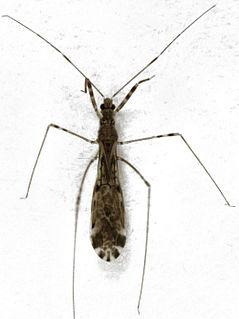 W
WEmesopsis infenestra is a species of assassin bug.
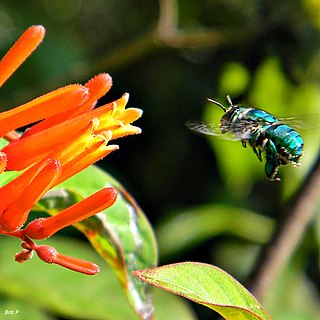 W
WEuglossa dilemma, the green orchid bee or dilemma orchid bee, is a species of solitary euglossine bee native to a broad area of Central America, and recently introduced to Florida in the United States. It was first detected in Broward County, Florida in 2003, and initially identified as Euglossa viridissima, but further study revealed that E. viridissima as previously defined consisted of two cryptic species, and the one present in Florida was new to science.
 W
WFormiscurra is a genus of planthopper in the family Caliscelidae with two species Formiscurra indicus found in southern India and Formiscurra atlas from southwestern Ethiopia. Like others of its family they have short wings, suck plant sap and escape by leaping. The species shows great sexual dimorphism. The males of this half centimeter-long insect have an enlarged lobe in front of its head, the frons or metope, giving it an ant-like appearance. Females do not have such an enlarged structure but have a slightly long snout and differ slightly in body shape. The species is found mainly on low vegetation in open scrub and grass habitats. It has been suggested, based on the Afro-Indian distribution, that the ancestral species of this and other genera Chirodisca and Rhinogaster, evolved in Eurasia and spread to Africa 5-7 million years ago when the Tethys sea closed and thus their ancestors would have been part of the late Miocene Hipparion fauna.
 W
WFormiscurra indicus is a species of planthopper in the family Caliscelidae found in southern India. A related species, Formiscurra atlas occurs in southwestern Ethiopia. Like others of its family they have short wings, suck plant sap and escape by leaping. The species shows great sexual dimorphism. The male of this half centimeter-long insect has an enlarged lobe in front of its head, the frons or metope, giving it an ant-like appearance. Females do not have such an enlarged structure but have a slightly long snout and differ slightly in body shape. The species is found mainly on low vegetation in open scrub and grass habitats.
 W
WIridomyrmex alpinus is a species of ant of the genus Iridomyrmex. It was described by Heterick and Shattuck in 2011.
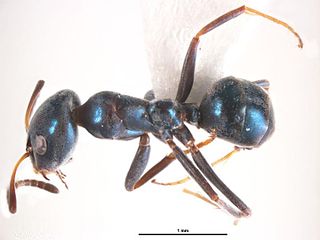 W
WIridomyrmex coeruleus is a species of ant in the genus Iridomyrmex. Described in 2011, these ants are endemic to Australia and New Guinea.
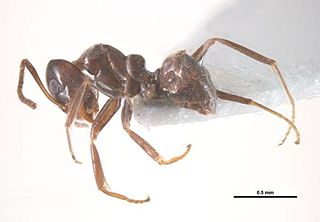 W
WIridomyrmex gibbus is a species of ant in the genus Iridomyrmex. Described by Heterick and Shattuck in 2011, the biology of the ant is not exactly known, although it is known that the ant is distributed in several states and in Barrow Island in Australia.
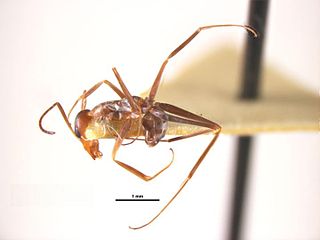 W
WIridomyrmex tenuiceps is a species of ant in the genus Iridomyrmex. Described by Heterick and Shattuck in 2011, the species is widespread in Australia.
 W
WKollasmosoma sentum is a parasitoid wasp in the family Braconidae, which lays its eggs inside adult ants. It was featured as one of "the top 10 new species of 2012" in a list compiled by Conservationists at the Arizona State University International Institute for Species Exploration.
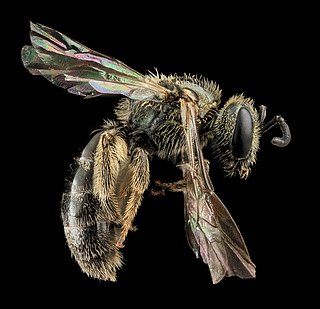 W
WLasioglossum gotham, commonly known as the Gotham bee, is an extant species of sweat bee native to Eastern and Midwestern United States.
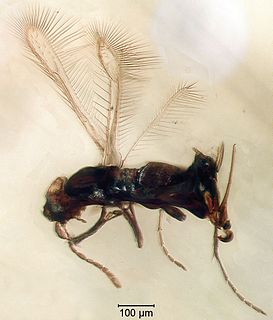 W
WMyanmymar is an extinct genus of fairyfly preserved in Burmese amber from Myanmar. It has only one species, Myanmymar aresconoides. It is dated to the earliest part of the Cenomanian stage of the Late Cretaceous, around 99 million years old. As of 2011, it is the oldest known fossil mymarid.
 W
WMyrmica elmesi is a species of ant in the subfamily Myrmicinae. The species, known from north-west Himalaya, belongs to pachei group, and is significantly different from all other described species of this group.
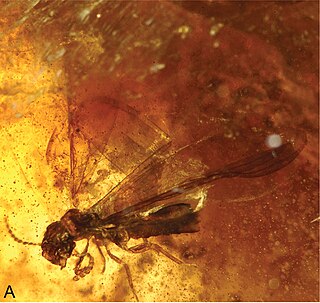 W
WNanotermes is an extinct genus of termites in the Isoptera family Termitidae known from only one Eocene fossil found in amber of the Cambay Basin. The genus contains a single described species, Nanotermes isaacae placed tentatively in the subfamily Termitinae.
 W
WOsmia calaminthae, commonly known as the blue calamintha bee, is a rare species of mason bee known only to Highlands County, Florida, United States. It is considered Critically Imperiled by NatureServe. The common name for the bee is derived from its distinctly blue color and its favored host plant, Calamintha ashei.
 W
WScaptia beyonceae is a species of horse fly found in the Atherton Tablelands in north-east Queensland, Australia. Discovered in 1981 but not scientifically described until 2011, the fly is named after American recording artist and actress Beyoncé.